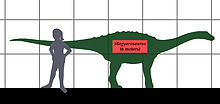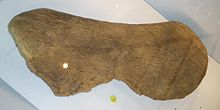- Magyarosaurus
-
Magyarosaurus
Temporal range: Late Cretaceous, 70 MaSize compared with a human Scientific classification Kingdom: Animalia Phylum: Chordata Class: Reptilia Superorder: Dinosauria Order: Saurischia Suborder: Sauropodomorpha Infraorder: Sauropoda (unranked): Titanosauria Genus: Magyarosaurus
von Huene, 1932Species - M. dacus (Nopcsa, 1915 [originally Titanosaurus dacus]) (type)
- M. hungaricus von Huene, 1932
Magyarosaurus ("Magyar lizard") is a genus of dwarf sauropod dinosaur from late Cretaceous Period (early Maastrichtian[1]) in what is now Romania. It is one of the smallest-known adult sauropods, measuring only six meters in length. The type species is Magyarosaurus dacus. Magyarosaurus was found to be a close relative of Rapetosaurus in the family Saltasauridae in the sauropod clade Titanosauria in a 2005 study of the titanosaurs by Kristina Curry Rogers.[2]
Contents
Discovery
Remains belonging to at least ten individuals have been recovered from the Hunedoara region (Sânpetru Formation) in what is now western Romania. Initially they were named Titanosaurus dacus, the specific name referring to the Dacians of ancient Romania, by Baron Nopcsa in 1915.[3] Nopcsa had collected fossils in the area since 1895. The species was later renamed Magyarosaurus dacus by Friedrich von Huene in 1932.[4] Von Huene in 1932 also named two other species: M. hungaricus and M. transsylvanicus. Larger, rarer M. hungaricus may represent a distinct taxon.[5]
The holotype, BMNH R.3861a, consists of a set of vertebrae. Numerous other bones have been found, mainly caudal vertebrae but also dorsals and elements of the appendicular skeleton. No remains of skulls are known. There have been a discovery of 14 fossil eggs which has been attributed to Magyarosaurus.[6]
Paleobiology
The islands it inhabited led to Magyarosaurus becoming a product of insular dwarfism as a result of selective pressures presented by limited food supplies and a lack of predators, all favoring a smaller body size.[5] This is seen in many other dinosaurs existing at the time, including the ornithopod Rhabdodon and the nodosaur Struthiosaurus. Nopcsa was the first to suggest island dwarfism as an explanation for the small size of Magyarosaurus compared to other sauropods. Later researchers doubted his conclusions, suggesting instead that the known Magyarosaurus fossil represented juveniles. However, a detailed study of bone growth patterns published in 2010 supported Nopcsa's original hypothesis, showing that the small Magyarosaurus individuals were adults.[5]
In popular culture
Magyarosaurus is featured in the second episode of the Discovery Channel TV series Dinosaur Planet as the dwarf titanosaur species living in the Cretaceous Hateg island.
Magyarosaurus is also featured in the sixth episode of the BBC TV series Planet Dinosaur.
References
- ^ Therrien, F., Zelenitsky, D.K. and Weishampel, D.B. (2009). "Palaeoenvironmental reconstruction of the Late Cretaceous Sânpetru Formation (Haţeg Basin, Romania) using paleosols and implications for the "disappearance" of dinosaurs." Palaeogeography, Palaeoclimatology, Palaeoecology, 272(1-2): 37-52. doi:10.1016/j.palaeo.2008.10.023
- ^ Curry Rogers, K. (2005). "Titanosauria: A phylogenetic Overview" in Curry Rogers, K. and Wilson, J.A. (eds), The Sauropods: Evolution and Paleobiology. Berkeley: University of California Press. ISBN 0-520-24623-3
- ^ Nopcsa, F. (1915). "Die Dinosaurier der siebenburgischen Landesteile Ungarns." UNGAR. GEOL. REICHSANST., 23: 1-26.
- ^ von Huene, F. (1932). "Die fossile Reptil-Ordnung Saurischia, ihre Entwicklung und Geschichte." Mong. Geol. Pal., 4(1) pts. 1 and 2, viii +361 pp.
- ^ a b c Stein, K., Csiki, Z., Curry Rogers, K., Weishampel, D.B., Redelstorff, R., Carballido, J.L. and Sander, P.M. (2010). "Small body size and extreme cortical bone remodeling indicate phyletic dwarfism in Magyarosaurus dacus (Sauropoda: Titanosauria)." Proceedings of the National Academy of Sciences, 107(20):9258–9263. doi:10.1073/pnas.1000781107
- ^ "Briefing", Geology Today 7(1): p. 2-6.
External links
Categories:- Cretaceous dinosaurs
- Titanosaurs
- Dinosaurs of Europe
Wikimedia Foundation. 2010.


